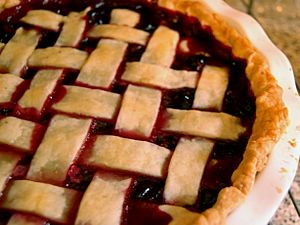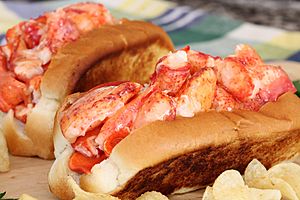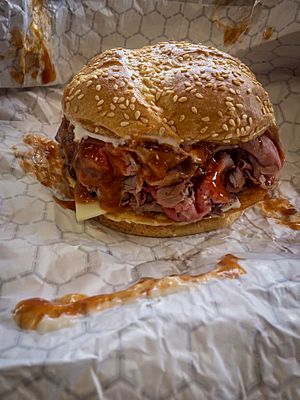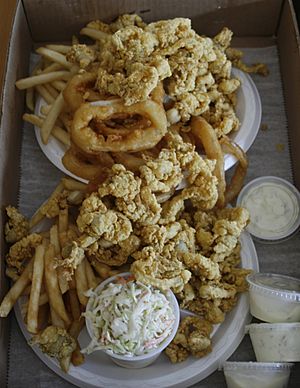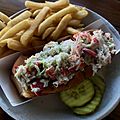Cuisine of New England facts for kids
New England cuisine is a type of food that comes from the New England area of the United States. It has roots in English cuisine. This cooking style uses a lot of seafood and dairy products. This is because New England has many seaports and a big fishing industry. There's also a lot of dairy farming inland.
Many early settlers, called Puritans, came from eastern England. They often baked foods like pies, beans, and turkey. This was more common than frying, which was popular in other places.
Two special foods from New England are maple syrup and cranberries. The main starchy food is usually potatoes. However, rice is becoming more popular today. New England cooking mostly uses ground black pepper. But parsley, garlic, and sage are also common. Some Caribbean spices like nutmeg and Italian spices are used too.
Using cream is common because of the dairy farms. Favorite cooking methods include stewing, steaming, and baking. Many local foods were learned from the Southern New England Algonquian cuisine. These include squash, corn, local beans, sunflowers, wild turkey, maple syrup, and cranberries. Dishes like cornbread, Johnnycakes, and Indian pudding also came from them.
Contents
History of New England Food
Early Native American Foods
The Wampanoag and Wabanaki Native American tribes had a traditional diet. It included foods like chestnuts, beechnuts, walnuts, beans, and colorful corn. They also ate different kinds of squash and pumpkins. While they ate some meat, their diet focused a lot on plants. They even made plant milk from nuts.
Colonial Times
In 1620, the Pilgrims arrived in Plymouth Colony. They faced a very cold winter and a short growing season. The colonists brought important ways to save food. These included smoking, curing, and drying food. These methods helped them get through the winter.
The Wampanoag people helped the Pilgrims a lot. They taught them how to grow important crops like squash, beans, and corn. We don't know exactly what was grown in the first gardens. But later, people mentioned turnips, onions, carrots, garlic, and pumpkins.
The Pilgrims used corn to make hasty pudding. They also learned Wampanoag recipes like popcorn, sagamite, and nasaump. The Wampanoag also taught them to bake in hot ashes. This led to ash cakes, also called johnny cakes, becoming a common breakfast bread. Beans were used in stews or mixed with corn to make succotash.
Many early Puritan settlers came from eastern England. They brought their English cuisine traditions with them. Foods like roast duck, goose, lamb, and ham became popular as the colonies grew. Even today, traditional English dishes are a big part of New England's food. Some of these, like clam chowder, baked beans, apple pies, and steamed puddings, are now enjoyed across the United States.
The First Thanksgiving Meal
The first Thanksgiving meal was shared by the Wampanoag and Pilgrims. This happened at Plymouth Rock. The food was much simpler than today's Thanksgiving dinner. Today, we often have turkey with stuffing, cranberry sauce, yams, mashed potatoes, and pumpkin pie.
Back then, they didn't have wheat flour or butter for pies. White potatoes and sweet potatoes had not yet come to North America. The first mention of cranberry sauce was about 50 years after this first meal.
The original menu included "Indian corn" and wild birds. These birds included wild turkey and waterfowl. They also ate venison. Food historians think other things might have been served too. Besides turkey, duck, and goose, swan and passenger pigeons were plentiful. Birds were often stuffed with onion and herbs. A 17th-century recipe for goose even used chestnuts for stuffing. It's also likely they ate local seafood. This included clams, mussels, lobsters, and eels.
Food in the 1800s
Since the 1800s, New England's food has been shaped by people from Ireland, Portugal, and Italy. For example, New England boiled dinner came from Irish-style braised pickled beef.
"Country stores" used to sell homemade jams, fruit preserves, and penny candy. Some crackers, called "common crackers," are still made with a recipe from 1828.
Modern New England Food
After World War II, July 4 celebrations often included steak, hot dogs, hamburgers, and grilled chicken. In the past, lamb was more common inland. Coastal towns often served salmon with dill mayo, peas, new potatoes, and corn on the cob. Desserts usually feature seasonal fruits. Examples are strawberry shortcake and blueberry pie.
Traditional Foods and Drinks
Casseroles, Soups, and Stews
Bringing one-dish casseroles to gatherings was common in New England. These included traditional versions of baked beans and succotash. Today, casseroles can be made with many different ingredients. Seafood casseroles often have cream sauce and a bread crumb topping.
American chop suey is a casserole with ground beef, macaroni, and a seasoned tomato sauce. In other parts of the U.S., it might be called American goulash.
Fruits of New England
Blueberries are made into jams and jellies. They are also used in breads and desserts like pies, cobblers, and cakes.
Wild beach plums are picked and used to make fruit preserves. These plums were grown for jelly in the 1930s. But today, beach plum products are not widely sold.
Local purple concord grapes are a mix of native and European grapes. These large, juicy grapes are used for grape juice, wine, and grape jelly. They are a common ingredient in peanut butter and jelly sandwiches.
Before the Pilgrims planted apple seeds from Europe, only crab apples grew here. Over time, the Pilgrims bred thousands of new apple types. William Blaxton planted the first apple orchard in 1625. Many early apple types came from New England. Today, apples are grown all over Massachusetts.
The first commercial cranberry growing was started by Captain Henry Hall. He found a way to cover the vines with sand to help them grow faster.
New England Hot Dogs
New England hot dog rolls are special. They are split on top instead of the side. They also have a more rectangular shape. These rolls are great for buttering and toasting. They are also often used for serving seafood like lobster or fried clams.
Sweet Maple Syrup
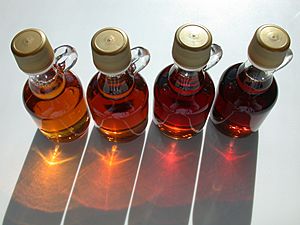
Maple sap is collected every year during New England's "sugaring season." The sap is then cooked down to make syrup. An old magazine from 1939 mentioned recipes like maple-butternut fudge and maple-sauce ice cream. "Sugar on Snow" is a special treat. It's made by pouring hot maple syrup on fresh snow. This makes a chewy candy.
Desserts like cobbler and maple custard pie were made with local sweeteners. These included maple sugar instead of regular sugar. Molasses and rum were also common in New England cooking. This was due to the Triangle Trade in the 1700s. Molasses from the Caribbean and honey were the main sweeteners for most people until the 1800s.
Sandwiches You'll Find Here
Some sandwiches are special to New England. These include baked beans on Boston brown bread. The Fluffernutter is another, made with Fluff marshmallow creme and peanut butter. It's usually served on Wonder bread.
Lobster rolls can be served cold or hot. They might have mayo or warm butter. Clam rolls are served with tartar or cocktail sauce on a New England-style hot dog bun. The chow mein sandwich has noodles, celery, onions, meat, and sauce in a hamburger bun. This one comes from Fall River, Massachusetts.
Delicious Seafood
The waters of the Gulf of Maine and Long Island Sound have many kinds of fish and shellfish. These are a big part of New England's food.
Commercial cod fishing started around Cape Ann in 1623. Salt cod was sent by ships to Africa. Cod, the fish that Cape Cod is named after, is still a main food in the area.
Bluefish are found around Cape Cod and Nantucket in the summer. They are eaten smoked, broiled, or sauteed. American lobster is usually grilled, steamed, or boiled.
Breaded deep-fried clams are popular in New England pubs. Clams can be soft shell or hard shell. Hard-shell clams are called littlenecks, cherrystones, or quahogs depending on their size. These are used for New England-style clam chowder. They can also be eaten steamed or raw. Soft-shell clams, also called steamers, are usually fried or steamed.
The clambake is a traditional New England meal. It came from Native Americans. Clams, lobsters, and corn are cooked over a firepit. Modern clambakes might also include mussels, fish, crabs, chicken, sausage, potatoes, and other vegetables.
Here are the official state fish and shellfish:
| State | Fish | Shellfish |
|---|---|---|
| Maine | Land-locked salmon (freshwater) | |
| Massachusetts | Cod | |
| New Hampshire | Striped bass (saltwater) Brook trout (freshwater) |
|
| Vermont | Brook trout Walleye pike |
|
| Rhode Island | Quahog | |
| Connecticut | Eastern oyster |
Seasonings and Spices
Many herbs, especially Mediterranean ones, don't grow well in New England. So, most savory New England dishes don't have very strong seasonings. They mostly use salt and ground black pepper. They also don't have many spicy foods.
Desserts often have spices like nutmeg, cinnamon, allspice, cloves, and ground ginger. These spices came from trade with the Caribbean region starting in the 1600s.
New England Pizza Styles
Much of the pizza in New England is Greek pizza. This is because many Greek Americans work in the food business here. Greek pizza has a chewy, bready crust, like focaccia. It's baked in a shallow, round metal pan with lots of olive oil. Greek-style pizzerias are often called "House of Pizza."
Italians started moving to New England about a century ago. So, pizza in Southern New England is more Italian-influenced. Famous places like Pepe's Pizza in New Haven, CT, serve thin, wood-fired pizzas. New Haven-style pizza has a slightly burnt, crunchy outside and a soft, chewy inside. This pizza style is similar to Neapolitan-style pizza.
Common New England Foods
-
-
- Clam cakes
- Clams casino
- Fried clams
- New England clam bake
- Stuffed clams
-
-
-
- Fried oysters
- Oyster stew
- Raw oysters on a halfshell
-
-
- Cranberry cocktail
- Cranberry mash/crushed cranberries
- Jellied cranberries
- Cranberry sauce
- Cranberry relish
- Cranberry bread
- Frappes or cabinets
- Hermits
- Ice cream
- New England boiled dinner
- New England Pot Roast (Yankee pot roast)
- Parker house rolls
- Pâté chinois
- Pumpkin pie
- Red flannel hash
- Rhubarb pie
- Snickerdoodles
- Steak bomb
- Steak tips
- Tourtière
Regional Specialties
Connecticut's Flavors
Inland Connecticut, like the Hartford area, shows Irish-American influences. In the 1700s, the Hartford election cake was a spicy, boozy cake. It was based on an English holiday cake. During the colonial era, elections were celebrated with drinks and a huge cake for the whole community. Hasty pudding is sometimes found in country areas, especially around Thanksgiving.
Italian-inspired food is very popular in the New Haven area. This city is famous for its charred, thin-crust New Haven-style pizza. It's baked in coal-fired ovens. The well-known white clam pie has fresh clams, olive oil, garlic, oregano, and grated Romano cheese. Some pizza places also offer subs on Italian bread, called "grinders." They also serve Italian dishes like eggplant rollatini, manicotti, baked ziti, and chicken parmesan. Famous pizzerias include Pepe's Pizza, Sally's Apizza, and Modern Apizza.
The food in Southeastern Connecticut relies heavily on local fishing. You can find typical New England seafood dishes at restaurants like Abbot's. Lobster rolls, crab cakes, oysters, clam chowder, and mussels are served with sides like potato chips and coleslaw.
Shad is the state fish. It's cooked on planks of wood over a fire, called a "shad bake." Taking the bones out of the fish needs skill.
Louis' Lunch started as a food wagon in 1895. Their burgers are still cooked in the original old cast-iron broiler. In Meriden, Connecticut, steamed cheeseburgers are a local specialty. They started as simple steamed cheese sandwiches in the 1900s.
Ice cream is made with milk from local creameries at UCONN Dairy Bar. They use a century-old recipe to make 24 flavors. Ferris Acres Creamery is a 150-year-old dairy farm that offers 50 ice cream flavors.
Maine's Delicious Offerings
Maine is known for its fresh, local foods and many farms. Northern Maine grows a lot of potatoes. Fiddlehead ferns were part of Native American cuisine. They are still popular in Maine, picked in springtime. Wild blueberries are a common ingredient or topping. Blueberry pie is the official state dessert when made with wild Maine blueberries.
Buckwheat pancakes called ployes are popular in Maine. They were originally a cheap and easy food. They could be eaten with maple syrup or cretons. Over time, they became a traditional dish. Ployes are a mix of buckwheat flour, wheat flour, baking powder, and water. They are very popular in the Madawaska region.
The whoopie pie is the official state treat. Maine is also where the needham comes from. This is a dessert bar made from chocolate, coconut, and potato. Salt water taffy is a popular item sold in tourist areas.
The city of Portland, Maine, is known for its many famous restaurants. It was even called "America's Foodiest Small Town" in 2009. Portland has a Farmers Market started in 1768. The city is also a top place for vegans and vegetarians.
Maine is famous for its lobster. Inexpensive lobster rolls are often available in the summer. These are lobster meat mixed with mayonnaise, served in a grilled hot dog roll.
The French-speaking part of northern Maine has many Acadian food influences. A popular dish is tourtière or meat pies. These are especially popular around Christmastime.
The Italian sandwich is popular in Portland and southern Maine. Portland restaurant Amato's says it invented the Italian sandwich in 1902. It's a submarine sandwich with ham, cheese, tomato, raw peppers, and pickles.
Moxie was America's first mass-produced soft drink. It is the official state soft drink of Maine. It's known for its strong aftertaste.
Massachusetts Specialties
Coastal Massachusetts is known for its clams, haddock, and cranberries. In the past, cod was also very important. Massachusetts has had many immigrants. Strong Eastern European populations brought kielbasa and pierogi as common dishes.
Fig Newtons were first made in 1891 in Newton. They used a machine to fill cookie dough with fig jam. Small, round Necco Wafers also came from Cambridge. Graham bread was first made in Massachusetts in the 1800s. Tollhouse cookies, the official state cookie, were created in 1930 in Whitman.

Boston is known for baked beans, which is why it's called "Beantown." It's also known for bulkie rolls and different pastries. Boston cream pie is actually a cake with custard filling.
Parker's Restaurant in Boston was a top dining spot in the 1800s. Its menu in 1865 included local seafood like oysters, fried clams, mackerel, and salmon. Other dishes included chicken fricassee, corned beef, and baked beans with pork. Sides included corn, rice, potatoes, and asparagus. Sweet desserts like Indian pudding, custard, and apple pie were also served.
The North Shore area is known for its roast beef sandwich shops. These sandwiches usually have thin-sliced roast beef on a hamburger bun. They might have lettuce, tomato, onion, cheese, mayo, and barbecue sauce. Most pizza and roast beef shops also serve "steak tips." These are marinated cubes of sirloin. Kelly's Roast Beef says it created the first roast beef sandwich.
Marshmallow Fluff was invented in Somerville, Massachusetts. Fluffernutter sandwiches, with peanut butter and marshmallow fluff, are popular. The South Shore area has a following for "bar pizza." These are crisp, thin pizzas with many toppings.
Common plant foods in Massachusetts are similar to northern New England. These include potatoes, maple syrup, and wild blueberries. Dairy farming is also big in central and western Massachusetts.
New Hampshire's Offerings
Southern New Hampshire food is like Boston's. It features fish, shellfish, and local apples. Like Maine and Vermont, French-Canadian dishes are popular. These include tourtière, often served on Christmas Eve, and poutine. Corn chowder is also common. It's like clam chowder but with corn and bacon instead of clams. Portsmouth is known for its orange cake.
Rhode Island's Unique Tastes
Rhode Island is known for johnnycakes, doughboys, and clam cakes. Johnnycakes can be thick or thin. People still argue if they should be made with milk or water. East of Narragansett Bay, they use cold milk and butter. But around South County, the batter is sweetened and made with hot cornmeal.
Johnnycakes were traditionally served as a flatbread with chipped beef or baked beans. Today, they are usually eaten for breakfast with butter and maple syrup. Real johnnycakes should be made with whitecap flint corn. This corn was historically grown around Narragansett Bay.
Sweetened coffee-flavored dairy products are popular in Rhode Island. Coffee milk has been the official state drink since 1993. It's made with coffee extract syrups.
Other popular foods include clear clam chowder, quahogs, milkshakes (called cabinets), submarine sandwiches (called grinders), pizza strips, the chow mein sandwich, and Del's Frozen Lemonade. Italian cooking is well-known here.
In Rhode Island, and other parts of New England with many Portuguese Americans, Portuguese foods are common. These include linguiça, chouriço, caldo verde, malasadas, and Portuguese sweet bread.
Vermont's Specialties
Vermont makes cheddar cheese and other dairy products. Small cheesemakers are known for their handmade cheddar cheeses. These include the Crowley Cheese Factory and Shelburne Farms.
The Vermonter sandwich has cold cuts (often turkey and ham), apple, sharp Vermont cheddar, and maple mustard. This toasted sandwich is served warm.
Vermont is famous for its maple syrup. Maple syrup is used in some Vermont dishes, like baked beans. Rhubarb pie is a common dessert. It's sometimes mixed with strawberries in late spring.
Restaurants and Pubs
The oldest restaurant still open in the United States is the Union Oyster House (1826) in Boston.
Legal Sea Foods is a chain restaurant that started by selling fresh fish and fish and chips. The first shop opened in 1950 in Cambridge.
Woodman's of Essex started selling homemade potato chips in 1914. Their famous dish of fried clams was introduced a few years later, in 1916. Their chowder has won awards.
Friendly's was founded in 1935 in Springfield, Massachusetts. It started as an ice-cream parlor. By 1960, they offered 63 flavors of ice cream.
On the North Shore of Massachusetts, "three-way" roast beef sandwiches are popular. They are often served on an onion roll with mayo, barbecue sauce, and American cheese. Kelly's Roast Beef says they created the first roast beef sandwich.
D'Angelo's is a regional chain with locations in several New England states. They specialize in subs. Their first shop opened in Dedham, Massachusetts in 1967. They serve foot-long lobster rolls and other sandwiches.
Italian sandwiches are the specialty at Moe's Italian Sandwiches. It was founded in Portsmouth, New Hampshire in 1959. Their sandwich is made with salami, provolone, veggies, spices, and olive oil. Amato's says it created the Maine Italian sandwich. It has ham, American cheese, onion, sour pickles, tomatoes, black olives, green peppers, and olive oil.
Food and Dairy Industries
Fluff marshmallow creme, used for Fluffernutter sandwiches, is made in Lynn, Massachusetts. Welch's, located in Concord, Massachusetts, makes grape juices, jellies, and jams from purple Concord grapes.
Autocrat is a company in Lincoln, Rhode Island. They make coffee and tea extracts. Their coffee syrups are used to make coffee milk. This became Rhode Island's official state drink in 1993.
The Moxie Beverage Company in Bedford, New Hampshire, makes the Moxie soft drink. It's flavored with gentian root extract. Moxie has been Maine's official soft drink since 2005.
Organic dairy company Stonyfield Farm is in Londonderry, New Hampshire. The ice-cream company Ben & Jerry's was founded in 1978 in Burlington, Vermont.
Images for kids
-
A lobster salad roll served with fries and pickles at a restaurant in Massachusetts.


